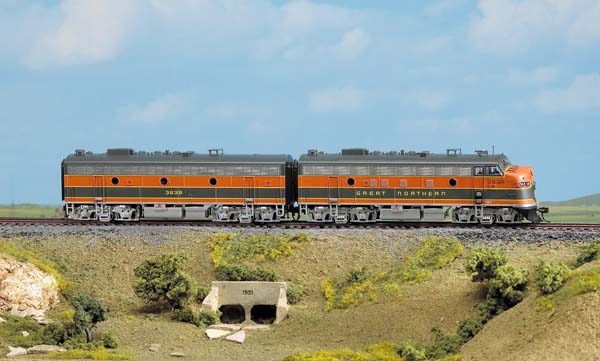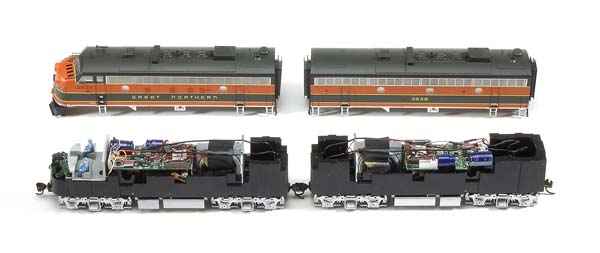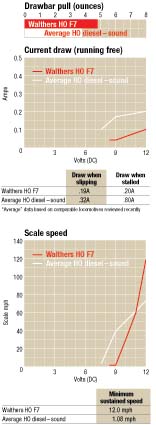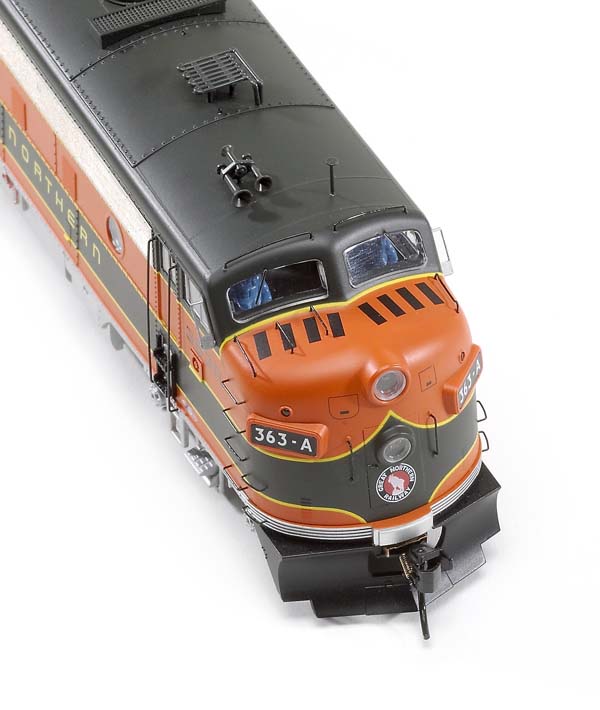The F7s were used in both freight and passenger service. Though the cab units worked well on passenger trains, poor rear visibility made them less than ideal for road switching. The lack of space between the 16-cylinder 567B engine and the carbody made the F7s more difficult to repair than hood units.
More information on the F7s can be found in Dana Kawala’s article “Modelers’ Guide to F units” in the October 2006 issue of Model Railroader magazine. Back issues can be ordered from our Customer Sales & Service Dept. (1-800-533-6644 or customerservice@kalmbach.com)
Walthers produces four different F7A bodies: with dynamic brakes and steam generator, with dynamic brakes but without steam generator, without dynamic brakes and steam generator, and without dynamic brakes but with steam generator. The Great Northern unit has the latter of the four.
In addition, the F7s feature numerous railroad-specific details. The GN F7A has a Leslie S-3L air horn, rooftop air-cooling coils, partial side skirts, snowplow pilot, winterization hatch with square corners, wind deflectors, nail-type antenna, and non-functioning modeler-installed backup light. The B unit features a similar level of detail. The specific details for each railroad are listed on the Walthers Web site, www.walthers.com.
I was pleased that Walthers used more-durable wire grab irons and eyebolts on the F7s,not acetal plastic as on other Proto 2000 diesels. The cab units also have chassis-mounted die-cast metal Proto Max magnetic knuckle couplers.
To remove the A unit’s shell, first unscrew and remove the draft-gear boxes. Then gently pry loose the four tabs attached to the porthole window glazing. The tabs are below the portholes closest to the front and rear doors.
Inside the shell is an injection-molded plastic gray cab interior with two painted figures, a printed-circuit (PC) board screw-mounted on top of the five-pole skew-wound motor, and two speakers mounted on an A-frame. A second, smaller PC board is attached to the chassis with two Phillips screws in front of the cab interior. Light-emitting diodes for the headlight, Mars light, and classification lights are soldered to this board. The wires are hidden under the interior.
The plastic F-type truck sideframes have crisply molded elliptical spring detail and separately applied brake cylinders and outside swing hangers. The sideframes are attached to the gear tower with two nubs that press fit into sockets, as well as square tabs that slip into an opening between the sockets. Small pins on the worm-gear cover (one on each side) lock into the square tabs to hold the sideframes in place. Correctly gauged 40″-diameter RP-25 contour metal wheelsets are mounted on metal axles with plastic helical gears and brass bearings.
The dual-mode QSI Quantum sound system provides realistic locomotive noises. The two A-frame- mounted speakers are located underneath the rear radiator fans. The factory setting for the volume is full blast, so you’ll want to use the supplied magnetic wand to lower it. Once adjusted, the sound effects are clearly audible. A 32-page booklet is included that describes analog and Digital Command Control features and programming.
The F7A has printed anti-skid strips on top of the nose; it also
has doors for the high-mount m.u. receptacles. The white numbers and letter on the number board are opaque and in the correct GN font.
All-wheel drive and electrical pickup
Clear classification lights
Detailed cab interior with crew
Die-cast metal chassis
Drawbar pull: 4.8 ounces
Five-pole skew-wound can motor
Helical gears, 14:1 gear ratio
Illuminated number boxes
Metal grab irons and eye bolts
Metal Proto Max knuckle couplers at correct height
Minimum radius: 18″
Operating Mars light
QSI Quantum sound system with dual speakers
See-through fans and grills
Sprung diaphragms
Weight: A unit 161/4 ounces, B unit 171/2 ounces
Prices: Direct-current: A and B units, $139 each; A-B set $269. Digital Command Control and QSI Quantum sound system: A and B units $189 each; A-B set $369.
Manufacturer
Wm. K. Walthers, Inc.
P.O. Box 3039
Milwaukee, WI 53201
Description
Plastic and metal ready-to-fun diesel locomotive
Road names: Great Northern; Atchison, Topeka & Santa Fe (freight, October 1953); Chesapeake & Ohio (blue and yellow); Chicago, Burlington & Quincy (freight); Milwaukee Road (orange and red); Soo Line (red and white); New York Central (black); and Southern Pacific (black widow)

















